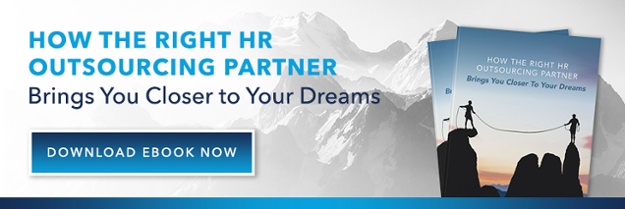Topic Outsourcing HR / PEO
HR Outsourcing and Fatigue Management
.jpeg)
February 26, 2021 | By Brandon Hartsaw
.jpeg)
As of January 2019, the National Safety Council estimated that about 13 percent of workplace injuries are attributed to fatigue and sleep problems. An employer with 1,000 employees could lose more than $1 million a year in absenteeism, reduced productivity, and increased healthcare premiums. Any resulting injuries increase workers' comp premiums. Fatigued workers are even more susceptible to illness and injury.
One surprising solution exists: HR outsourcing. HR outsourcing can mitigate and address fatigue in several ways.
What is Fatigue?
Fatigue is more than just feeling tired. Fatigue involves a major lack of energy and both physical and mental exhaustion. Everyone has days when they are tired. A person suffering from fatigue is tired or exhausted consistently, never quite regaining their energy.
Somebody who is fatigued wakes up as tired as when they went to bed. This can be caused by medical problems, but also by working extended or unusual shifts. Fatigue can be caused by working shifts that contradict an employee’s natural sleep pattern.
Signs of Fatigue
So, how can you tell if an employee or employees are suffering from fatigue? There are some signs and symptoms of fatigue you can watch for:
- Sleepiness or drowsiness on the job.
- Irritability, being difficult to get along with.
- Calling in sick more often.
- Difficulty recalling details, such as forgetting the contents of a meeting quickly.
- Increased risk-taking.
- Reduced attention, reaction time, and ability to plan.
- More errors in judgment, more "stupid mistakes."
Fatigue can also cause headaches and digestive problems. Your employee may not realize that they themselves are suffering from fatigue.
How Can Employers Manage Employee Fatigue?
The first step is to be aware of employee fatigue and of factors that might increase it. Fatigue is more likely when workers have long commutes or unusual shifts. It may also affect employees who have family stress or are new parents.
Here are some things you can do to fight fatigue:
Create a Fatigue Policy
Assess fatigue factors that are induced by the nature of your workplace and create a policy to mitigate them. This might, for example, include mandatory downtime for employees on rotating shifts or sending people home without disciplinary action if they are clearly too tired to work.
Wellness Program
Some fatigue factors don’t have anything to do with the workplace. Fatigue can be caused by excessive use of alcohol on the weekends, insomnia, and sleep apnea. New parents are particularly vulnerable to fatigue because - as anyone who has cared for a baby knows - they don't sleep. Consuming caffeine too late in the day is unhelpful. While you can't control people's off-the-clock behavior, a good wellness program both incentivizes good behavior and educates employees on why, for example, it's not a good idea to drink coffee after 7 pm.
Recovery Breaks
Allowing and encouraging recovery breaks can make a huge difference. Some offices have added a nap room where a tired employee can take a 10-minute power nap. Employees who are working at home can also be encouraged to use break time to nap. Microbreaks can help many office workers. Encourage your workers to get up and stretch periodically, especially if they feel blocked. It's also a good idea to encourage workers to leave their office for their lunch break.
Safety Education
Make sure that your safety education program covers fatigue, how to identify it in yourself, and when to take a break. Fatigue strongly impacts safety, and it's better for somebody to take a break or switch to a less dangerous task than to cause an accident.
Reducing Overwork
Overwork is a major cause of fatigue. Make sure that you are not expecting long hours, especially from salaried workers (who may feel that they have to be on the clock as much as possible).
Planning Shifts
Plan your shifts to reduce irregular and extended shifts. One way to mitigate fatigue is to find out who your "early birds" and "night owls" are and plan shifts accordingly. Letting your employees work shifts that fit with their natural sleep pattern can really help. Allowing staggered shifts can also help, by allowing employees to choose a commute time that reduces traffic and makes their commute shorter and less stressful.
How Does HR Outsourcing Mitigate Worker Fatigue?
So, how can HR outsourcing help? The first and most obvious benefit is that it reduces extended hours being worked by your HR person or team. By handing off the routine, tedious tasks that can be extremely draining to the HR solution, your HR team will work fewer hours, and be less burdened with complicated compliance issues. Alternatively, they can then use the time that has been freed up to develop fatigue policies and work on best practices to fight fatigue.
HR outsourcing also supports a couple of other things which can be very useful:
- Flexible benefits plan. Because your employees can take advantage of the better benefits offered by the HR outsourcing solution, they can choose benefits that fit their particular situation. This then results in them being healthier overall.
- Safety program. Because your HR outsourcing partner has experience with multiple clients, they can help you set up world-class safety programs that include fatigue mitigation.
Worker fatigue is a significant cause of accidents, absenteeism, lost productivity, and increased healthcare costs. HR outsourcing can help you fight fatigue by freeing up your HR team to do a better job of developing policies, offering a wider variety of benefits, and developing best-in-class safety education.
.jpg)
Brandon Hartsaw
Acting as the Chief Operations Officer, Brandon actively promotes an environment of creativity, collaboration, and individual ownership to empower Questco team members to deliver exceptional client experiences.




